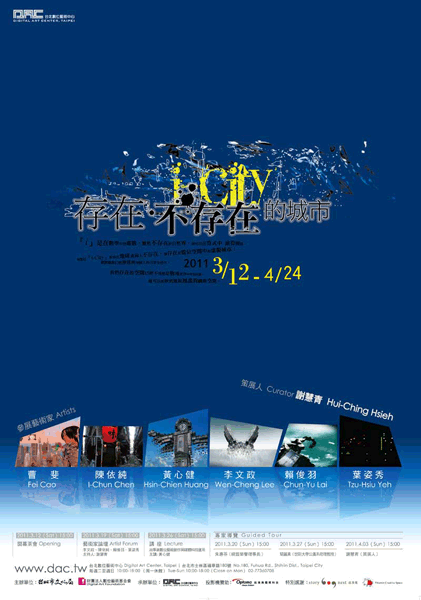《存在。不存在的城市》i-City: Virtual Cities in Digital Space
ꕥ 展期 Duration:2011/03/12 (六) – 2011/04/24 (日)
ꕥ 開幕 Opening:2011/03/12 (六) 15:00
ꕥ 地點 Venue:台北數位藝術中心
ꕥ 地址 Address:111台北市士林區福華路180號;近捷運淡水線芝山捷運站二號出口
ꕥ 展覽介紹
存在.不存在的城市 i-City
策展人: 謝慧青
參展藝術家:曹斐、陳依純、黃心健、賴俊羽、李文政、葉姿秀
「i」是數學中的虛數,雖然不是存在於自然界中的自然數,而卻可以在算式中演算開展。本次展覽以「i-City」比喻在現實中不存在,而卻存在於數位空間中的虛擬城市。藝術家所架構而成的數位城市,在地球表面的物理空間不存在,地圖上也找不到,而卻存在於數位空間之中,可任人遨遊。
「存在.不存在的城市i-City」展覽是由謝慧青所策畫,參展藝術家包括: 曹斐、陳依純、黃心健、賴俊羽、李文政、葉姿秀,共六位來自台灣與大陸的優秀藝術家,作品以新媒體藝術為主,呈現方式豐富多元,包括:即時互動裝置、環狀投影裝置、錄像藝術、數位輸出、電視牆、網路藝術等等。
藝術家擷取真實城市中所見的建築元素或街頭風景,解構之後在數位世界中重建,創造出另一個混雜而又異質化的虛擬城市,與真實城市平行、相似卻又截然不同。作品中的虛擬城市,一方面反映了真實世界中的城市文化,是如何在全球化的浪潮下被衝擊碰撞,產生出各種混雜並存的異質文化的狀態。另一方面,也反映出在現今社會中,網際網路已經滲透到每個人的日常生活,我們所存在的空間已經不僅僅是物理世界中所見所聞,而已經透過網路延伸到無限無盡的網路空間,而數位城市是可以由我們自由建構、自由想像。
Real/Virtual: i-City
Curator: Hui-Ching Hsieh
Artists: Fei Cao, I-Chun Chen, Hsin-Chien Huang, Chun-Yu Lai, Wen-Cheng Lee,
Tzu-Hsiu Yeh (In alphabetical order)
Although not a natural number which exists in the natural world, “i”, an imaginary number in mathematics, can be calculated in equation. This exhibition uses the term of “i-City” to make an analogy of a virtual city that doesn’t exist in reality but does in the digital space. Those digital cities configured by artists are neither existent within physical space on earth nor can be found on the map; however, they exist in the digital domain that can be traveled by human beings.
Real/Virtual: i-City, curated by Hui-Ching Hsieh, includes six artists from both Taiwan and Mainland China: Fei Cao, I-Chun Chen, Hsin-Chien Huang, Chun-Yu Lai, and Wen-Cheng Lee, Tzu-Hsiu Yeh. This exhibition features on diversified forms of new media arts, including interactive installation, circular projection, video art, digital output, TV wall, cyber art, and so on.
By first deconstructing images which are retrieved from urban architectural elements or street snapshots in the real city, artists then recreate another hybrid and heterogeneous virtual cities that are not only paralleled to and similar to real cities but also drastically different to real ones. Virtual cities in the works one hand reflect how urban culture in real world are challenged and contended under the wave of globalization and therefore produce urban cultural entity that is tangled with various cultural heterogeneity; on the other hand, they reflect how everyone’s daily life is infiltrated by the internet in the contemporary society. Our living space no longer exists in what we have experienced in the physical space, but, by means of internet, extends to the infinite cyber space in which we can freely construct and imagine a digital city.
﹉﹉﹉
存在.不存在的城市策展論述 Curatorial Philosophy
i -City:數位空間中的虛擬城市
策展人Curator / 謝慧青
時間與空間的後現代混亂中,時間的連續性崩解成為延伸,空間向度失落成為複本,都市文化轉變為巨型全息圖,可以在顯而易見的空無中生產各種影像。時間和空間在這個過程中,—轉化為自身的圖像,並進而化為情景。
~Celeste Olalquiaga in Megalopolis
「i」是數學中的虛數,雖然不是存在於自然界中的自然數,而卻可以在算式中演算開展。本次展覽以「i-City」比喻在現實中不存在,而卻存在於數位空間中的虛擬城市。藝術家所架構而成的數位城市,在地球表面的物理空間不存在,地圖上也找不到,而卻存在於數位空間之中,可任人遨遊。
三月中旬於台北數位藝術中心開展的「存在.不存在的城市i-City」展覽,參展藝術家包括: 曹斐、陳依純、黃心健、賴俊羽、李文政、葉姿秀,共六位來自台灣與大陸的當代藝術家,作品以新媒體藝術為主,呈現方式豐富多元,包括:即時互動裝置、環狀投影裝置、錄像藝術、數位輸出、電視牆、網路藝術等等。
第三空間
數位空間的概念也顛覆了我們過去對空間的觀念,超越了我們所經驗的實體空間地理的概念,可能隨著手指點一下滑鼠或鍵盤,隨即變化轉換到不同的網路空間,它是自由移動、瞬息萬變的。許多學者也以類德勒茲(Gilles Deleuze)的「根莖」概念來比喻網路的水平游移、網狀連接的結構。這樣的數位空間不是我們真實世界所接觸的生活空間—「第一空間」,也不是也不是概念所生成的構想的空間—「第一空間」;而是擁有索雅(Edward W. Soja)所描繪的「第三空間」的特色:具有「真實與想像兼具」的性質,是一種「其他(an-Other)的理解與行動方式,著眼於改變人類生活的空間性,一種獨特的批判性空間察覺。」
藝術家挪用真實城市中所見的建築元素或街頭風景,解構之後在數位世界中
「再現空間」,創造出兼具真實與想像特質的城市空間,同時也以各種變形、轉化、象徵、移置的手法來對對真實世界進行反諷與顛覆。藝術家們創造出另一個混雜而又異質化的虛擬城市,與真實城市平行、相似卻又截然不同,再現了異質化的第三空間;作品中的虛擬城市,一方面反映了真實世界中的城市文化,是如何在全球化的浪潮下被衝擊碰撞,產生出各種混雜並存的異質文化的狀態。另一方面,也反映出在現今社會中,網際網路已經滲透到每個人的日常生活,我們所存在的空間已經不僅僅是物理世界中所見所聞,而已經透過網路延伸到無限無盡的網路,而數位城市是可以由我們自由建構、自由想像。
混雜與異質的重組
曹斐的《我‧鏡》以及《人民城寨的生活》,是以她在第二人生網路平台中的化身中國‧翠西為主角所拍攝的短片。在《人民城寨的生活》中,透過翠西與他的孩子中國‧山之間的問答,逐漸揭露了人民城寨建設的過程與虛擬城市的特性,以及真實世界與之對應的關係。中國各大城市過去幾年來大興土木,如本有許多老胡同以及古蹟建築的北京城,突然之間與西方建築師所打造出的現代建築交相雜處,使得北京的城市風貌充滿了混雜與異質性。曹斐將這樣的有如第三空間的北京城解構重組,並混雜入上海、香港以及西方的建築,重組再現為人民城寨(RMB City), 其中充滿了藝術家個人遊戲式的嘲諷式:大熊貓、中央電視台被懸吊在空中,古根漢美術館變成甜甜圈等等。
《我‧鏡》共有三部分,是曹斐在第二人生中的旅程紀錄。第一部份描繪了曹斐心中的這個由金錢所打造的世界,雖然是虛擬的,但卻是一個相當資本主義的世界,現實中帶著冷酷。第二部分則反應了曹斐在第二人生的世界中所遇到的真情。雖然化身是虛擬的,然而與網路中遇到的朋友,交往共渡的時間與情感卻是再真實不過的感受;第三部分則反映出在此世界中跨越種族、國界的世界觀。雖然這是一個由金錢、消費所建構的虛擬世界,卻仍然吸引了許許多多各型各色的人們來到這個世界中。
在《上海,我能請你跳支舞嗎?》中,黃心健擷取了上海城市中各時代的建築元素,透過與觀眾的互動,隨機選取的城市建築外觀組合形成與觀眾相同輪廓的人型,隨著音樂舊上海時代的舞曲而翩翩起舞。古典的鐘樓、山型牆、紅磚,與現代的水泥公寓、陽台鐵窗等等各種上海城市可見的建築外觀,隨著觀眾的來來去去,交織、重組,又崩裂消失;建築凝聚了人類歷史的記憶,在時間的洪流中傾頹消失,在數位世界中重新化身為人,串連著小市民的城市記憶與夢想,組成一曲城市建築的數位之舞。
城市的數位寓言
李文政與賴俊羽作品中的數位城市,是對應於真實城市的象徵式寓言,敘述了他們對自身所在城市的觀察與省思。在M型資本分布、貧富差距日益拉大的現代社會,以及文化全球化的浪潮中,日、韓、美、中等各地文化滲透到台灣,文化的混雜並存,也影響了城市的發展與面貌。賴俊羽的《歿日》中,太陽由林立的高樓華廈中升起,色彩鮮艷的招牌上卻是標示著「天災人禍」、「惡鬥與衝突」、「假基督出現」等等警世的標語;卻沒料到太陽的升起,帶來的卻是爆炸與末日,世界崩毀又重生,最後重新回歸於鐵皮與木板搭建的貧民聚落。在兩種城市型態的落差之中,也看到藝術家對現今M型社會結構的憂心。
而李文政的《看見不見的海》,則讓象徵著台灣的島嶼,在一片空無的海平面中升起,台灣日常生活中常見的建築元素組合成這個充滿生機的島嶼都市,不料卻被巨龍吞噬,爾後又幻化重生為巨大的機器人,光芒萬丈平地升起,變形為巨大的宇宙都市。而《卉花博覽會》中,城市建築變異化身的巨大怪獸,現身於台北花博展館附近的城市空間,是藝術家對台北花博所產生的社會怪現象,提出反省與嘲諷。台灣常見的城市景觀,如:高樓、公寓、窗戶、霓虹燈、廣告、紅綠燈、橋梁、摩天輪等等混雜的建築元素,在李文政的作品中彷彿是機械的模型組件,如同變形金般組合變身為各種巨大怪獸,由地景中湧現,再度降臨於原本的地貌;騷動著的是根植於本土市民們的生命能量,各種混雜並陳的城市景觀也正是台灣城市風貌的寫照。
資訊的空間轉化
馬歇爾‧麥克魯漢(Marshall McLuhan)主張,任何技術都逐漸創造出一種全新的人的環境,此新環境並非消極的包裝用品,而是積極的作用進程,而這些新環境把之前的舊環境轉變為一種人為的藝術形式。葉姿秀的《微訊》,是將城市中所產生、使用傳播的電子訊號與數位訊息,轉化為不同色彩的光源;在漆黑的房間中,藝術家布置了無數個微小的各色LED小燈,不斷地明暗閃爍,在黑暗建構成一個虛幻的城市;在不知不覺中,各種資訊產品已經不知不覺地滲入到我們的生活四周,在物理的空間中構成了另一種資訊的網絡空間。
陳依純《一封可憐的信件標題,當你開啟卻中毒了!》中,藝術家以無窮無盡的後街小巷來比喻網路中的空間連接。當你漫遊在網路中時,隨時可能會遇到病毒木馬,就像是在實際的城市空間中,徘徊在迷宮般的防火小巷中,擔心會遇到埋伏的歹徒;展在眾多的後巷入口,你該選擇哪一條路呢?影像前不時飛過一架飛機、掠過一個模型女孩,或是招牌或燈籠,甚至是公雞、黑狗或犀牛。在網路時代中,你可能透過偶然的連結,進入不同的網頁空間,有時會有驚奇的發現,有時是無趣的垃圾,而有時也會遇到危險!網路空間成了網民們每天必定探入的世界,也是我們越來越熟悉的世界;首頁就是大門口,而這門口通往世界各地。陳依純以現實中的空間元素,再現了她對網路空間的真實感受。
六位藝術家們以現實中的城市元素再現了他們對城市的印象以及感受,構築了充滿想像力以及令人驚奇的虛擬城市。誰說虛擬城市是不存在的呢?它,存在於你我的真實感受之中。
i-City: Virtual Cities in Digital Space
Real/Virtual: i-City Curatorial Philosophy
Hui-Ching Hsieh, curator of Real/Virtual: i-City
The postmodern confusion of time and space, in which temporal continuity collapses into extension and spatial dimension is lost to duplication, transforms urban culture into a gigantic hologram capable of producing any image within an apparent void. In this process, time and space are transformed into icons of themselves and consequently rendered into scenarios.
Celeste Olalquiaga in Megalopolis1992, 19 (qtd. in Soja 237)
Although not a natural number which exists in the natural world, “i”, an imaginary number in mathematics, can be calculated in equation. This exhibition uses the term of “i-City” to refer to a virtual city that doesn’t exist in reality but does in the digital space. Those digital cities configured by artists are neither existent within material space on earth nor can be found on the map; however, they exist in the digital domain that can be traveled by human beings.
Real/Virtual: i-City, which is inaugurated in Taipei Digital Art Center in mid-March, includes six artists from both Taiwan and Mainland China: Fei Cao, I-Chun Chen, Hsin-Chien Huang, Chun-Yu Lai, and Wen-Cheng Lee, Tzu-Hsiu Yeh. This exhibition features on diversified forms of new media arts, including interactive installation, circular projection, video art, digital output, TV wall, cyber art, and so on.
Thirdspace
By finger-clicking on a mouse or a keyboard, soon we switch to different cyber space. The concept of digital space in which we can transcend beyond what we have experienced in the material spatial geography also subverts what we used to comprehend space. That is, it (digital space) is free to move and highly changeable.
Many scholars have employed ideas that are similar to Gilles Deleuze’s concept of “rhizome” to explain internet lateral mobility and network structures. The digital space is neither “Firstspace”, the real material world, nor the “Secondspace”, which is constructed by “imagined” ideas. Instead, according to Edward W. Soja, it has the characteristic of “Thirdspace”—a place that combines both “real-and-imagined” qualities. It is “an-Other way of understanding and acting to change the spatiality of human life, a distinct mode of critical spatial awareness.” (Soja, 10)
By appropriating images which are retrieved from urban architectural elements or street snapshots in the real city, artists then deconstruct those images to “re-present space” in the digital world. They not only create both real-and-imagined urban space, but also subvert and satirize what they have perceived in the real world through approaches such as various metamorphoses, transformation, symbolization, and displacement. Artists recreate hybrid-and-heterogeneous virtual cities that are not only paralleled to and similar to real cities but drastically different to real ones as well. Thus, these virtual cities are the re-presentation of heterogeneous Thirdspace. On one hand, virtual cities in the works reflect how urban culture in real world are challenged and contended under the wave of globalization and therefore produce an urban cultural entity that is tangled with diverse cultural heterogeneity. On the other hand, virtual cities reflect how everyone’s daily life is infiltrated by the internet in the contemporary society. Our living space no longer exists in what we have experienced in the physical material space, but, by means of internet, extends to the infinite cyber space in which we can freely construct and imagine a digital city.
Reintegration of Hybridity and Heterogeneity
Fei Cao’s Mirror and Live in RMB City are short films featuring on China Tracy, the second-life embodiment of Fei Cao in the cyber world. In Live in RMB City, through dialogues between China Tracy and her son, China Sun, the process of constructing RMB City and features of virtual cities gradually reveal. In addition, Live in RMB City divulges corresponding relations between the virtual and the real world. Beijing’s landscape is filled with hybridity and heterogeneity—a mixture of Western modern buildings and Chinese traditional architectures such as Hu Tong—because China has been undergoing a construction boom. In RMB City, a collage of diverse architectural elements from Shanghai, Hong Kong, and Western, where Fei Cao deconstructs and reiterates Beijing, which is similar to the concept of Thirdspace, there is full of artist’s personal playful sarcasm: big panda and China Network Television (CNTV) hanging in the sky, and a donut Guggenheim Museum.
There are three parts in Mirror, and it is Fei Cao’s traveling documentation in second life. The first part portrays the money-built world within Fei Cao’s mind. Although this world is fictional, it is a quite capitalized one which bears shrewd cruelty. The second part reveals true feelings that Fei Cao has in her second life. Her embodiment might be a virtual one; however, what she has committed in this world is utterly real emotion. The third part unfolds a worldview that transcends race and national boundaries. This might be a virtual world which is established by money and consumptive value, but it still attracts multiple kinds of people to visit.
In Shall We Dance Shanghai, by randomly selecting architectural cityscape that Hsin-Chien Huang extracts from different periods of Shanghai along with human-sized shapes, simultaneous interactions ensue the audience to dance with the music of old Shanghai. Architectural cityscapes in Shanghai such as classical belfries, pediments, red bricks, modern cement building, balcony, and iron-grid window altogether interweave, reiterate, and disappear with the coming and going of the audience. Architectures gather the memory of human history, and decay in the river of time. In the digital world, however, they have reincarnated through the form of human, which connect urban memories and dreams among citizens and compose a digital song of urban architectures.
A Digital Allegory in the City
In Chun-Yu Lai and Wen-Cheng Lee’s works where they narrate what they respectively have observed and introspected in relation to their situated cities, digital cities are symbolic allegories in response to real cities. Under the wave of globalization, in a modern M-shape society in which the gap between the rich and poor increase, Taiwan has been infiltrated with disparate cultures including Chinese, Japanese, and Korean. As a result, these trends influence Taiwan’s development and cityscape—a mixture with cultural hybridity. In Chun-Yu Lai’s Dying Sun, sun rises from high-rise mansions, accompanied with signboards saying “Catastrophe”, “Fighting and Confliction ”, and “ Pseudo Christ Apparition”. It never occur to us that sun rising brings us nothing but explosion and apocalypse—a world that is destroyed and then reborn—which lead us to a world of iron roofs and wooden partition ghettoes. By showing contrast distributions of two urban developments, we capture the worry that the artist has toward the M-shape social structure.
Wen-Cheng Lee’s Seeing Invisible Ocean signifies the exuberant island of Taiwan which is composed of architectural elements in our daily life. When rising from pure sea-level horizon, Taiwan suddenly is engulfed by a gigantic dragon, and reborn as a great robot which then transforms into an enormous cosmic city, rising with rays of light. As for Disappeared Flora Exposition, in which a gigantic monster that is transformed from an urban architecture appears near the site of Taipei Flora Expo, it is artist’s reflection and sarcasm toward social phenomena that are caused by such an event in Taipei. Common disparate architectural elements in Taiwan cityscapes—high-rises, apartments, windows, neon light, advertisements, traffic light, bridges, and Ferris wheel—altogether are model components of a machine which acts as a transformer that, emerging from the earth and ascending the former landscape, would later become huge monsters. What rattles is the life energy that is rooted in local inhabitants, and therefore this work which is filled with hybrid cityscapes exactly portrays Taiwan.
The Spatial Transformation of Information
Marshall McLuhan asserts that any technique will gradually create a brand new human environment which represents a positive progression, instead of a pessimistic product, and will turn old environment into a man-made art form. In Micro-Signal, Tzu-Hsiu Yeh transforms electro-digital signals that are produced and broadcasted within cities into the source of light in different colors. Within a dark room, the artist establishes a fictional city continually twinkling with numerous small LED light. All kinds of IT products have entered our lives, without our consciousness, and have constituted another informational cyber space within the physical space.
In I-Chun Chen’s An Email with Pitiable Subject, You Are Attacked by Virus!, artist make an analogy between endless alleys and network spatial connections. When you surf on the internet, you might receive a Trojan Horse virus in any minute. It is likely that you would be afraid to bump into lurking robbers when loitering in maze-like streets in real urban space. Which road should you choose when standing in the many entrances which lead to different alleys? Especially once in a while an airplane flies through a girl-model, a signboard or a lantern, even a rooster, a black canine or a rhinoceros. In the age of internet, you might, through occasional hyperlinks, enter different web space in which sometimes you find things amazing, sometimes you bump into boring rubbish, and sometimes you encounter danger! Web space becomes the world that internet users are bound to explore, and it is the world that we are getting more and more familiar with. Homepage is the gate to the world. I-Chun Chen represents how she really feels with spatial elements that she retrieves in the real world.
Six artists demonstrated how they felt toward the city with urban elements that they acquired in reality; hence, they established wondrous virtual cities that were full of imagination. Who says the inexistence of a virtual city? It does really exist among our genuine feelings.
Work Cited
Soja, Edward W. Thirdspace: Journeys to Los Angeles and Other Real-and-Imagined Places. Cambridge: Blackwell, 1996. Print.
﹉﹉﹉
策展人簡介 Curator
謝慧青 Hui-Ching Hsieh
http://cc.shu.edu.tw/~hchsieh/
e-mail: hsu.hsieh@msa.hinet.net
學歷
2004~ 輔仁大學跨文化研究所博士候選人
獲獎記錄
2009 世安美學論文獎,首獎。論文「Cyborg身體再現—基因改造與派崔西亞‧佩契妮妮作品」
2009 第三屆數位藝術評論獎。論文「虛擬身體之身份建構與性別扮演—以網路藝術作品為例」
現任
中華民國畫廊協會產經研究室計畫主持人、世新大學通識中心兼任講師(2004~)、中原大學通識中心兼任講師(2005~)、致理技術學院通識中心兼任講師(2006~)、台北護理健康大學院通識中心兼任講師(2009~)
專長 當代藝術、新媒體藝術、科技文化研究、視覺文化研究、性別研究
經歷
文化建設委員會2009, 2010年公共藝術講習執行小組、建築Dialogue雜誌主編、中國科技大學視覺傳達學系兼任講師、 台視文化公司玩藝時代雜誌主編、鶯歌陶瓷博物館典藏組研究人員、典藏今藝術雜誌主編、
自由時報藝文小組視覺藝術路線記者 、 紐約市美華藝術協會Chinese American Arts Council 客席策畫人 、藝術家雜誌社、藝術新聞雜誌社紐約特約撰述 、紐約中華新聞文化中心台北藝廊行政助理 、 香港明報紐約分社記者 、 中央研究院物理研究所研究助理
策展經歷
◎「i-City:存在.不存在的城市」策展人,台北數位藝術中心,2011年3月12日至4月10日。
◎「虛擬身體i-Body:網路世界中的身體建構與身分認同」線上策展,國美館 台灣數位藝術知識與創作交流平台,2010年12月。
◎「新山水 動水墨」,台北悠閒藝術中心,2010年6 月10日至7月17 日。
◎「意在形外—中國文字的解構與重現」,紐約林肯中心考克畫廊,1998年8 月4日至24日
◎「五個女人的床事—台港中女性藝術家聯展」,台北悠閒藝術中心,2000年10月28日至12月8日。新竹竹師藝文空間,2000年12月20日至2001年1月12日。
出版
◎《現代美術大系—現代造型陶藝》。台北:文建會策劃,藝術家出版社發行,2005年。
近期文章
◎〈捉迷藏-曾御欽作品的心靈迷宮〉,國藝會藝評台,2011年1月。
◎〈從科技文化到視覺藝術:派翠西亞˙帕契妮妮作品的生物混種與身份越界〉, 《美育》雙月刊,2010年11月。
◎〈水墨的當代轉向: 新山水 動水墨策展論述〉,《藝術家》雜誌,2010年9月號。
◎〈當代藝術中的台灣意識—從全球化與在地化觀點看台灣近二十年的美術發展〉,《美育》雙月刊,2010年5月。
◎〈虛擬身體之身份建構與性別扮演—以網路藝術作品為例〉。《第三屆數位藝術論文獎》。台北市文化局,2009年12月。
◎〈再現高雄灣消失的紅樹林—旗津風車公園中的《生態樂園》〉,《第二屆公共藝術獎》。台北:文建會,2009年12月。
◎〈邊緣與重生—當代台灣原住民女性心靈與藝術再現〉,《美育》雙月刊,2009年11月。
◎〈漂流生態台灣原住民女性藝術〉,《婦研縱橫》89期,2009年1月。
◎〈衍生的秩序—伊東豊雄專訪〉,《建築Dialogue》雜誌123期,2008年4月。
◎〈校園舊建築變身現代博物館—台灣藝術大學藝術博物館〉,《建築Dialogue》雜誌123期,2008年4月。
◎〈第十一屆威尼斯建築雙年展冰島館〉,《建築Dialogue》雜誌,2006年11月。
◎〈解析霍爾的移動城堡中的性別呈現〉,《日本動畫五天王》。台北:大塊文化,2006年。
其餘文章散見藝術家雜誌、典藏今藝術雜誌、藝術新聞雜誌,建築Dialogue雜誌,自由時報等等。
Hui-Ching Hsieh
http://cc.shu.edu.tw/~hchsieh/
e-mail: hsu.hsieh@msa.hinet.net
Education
2004~ Ph.D. Candidate, Graduate Institute of Comparative Literature, Fu Jen Catholic
University
1995 M.A. Liberal Studies Program, Simmons College
1993 M.S. Physics Department, Northeastern University
Award
2009 S-An Cultural Foundation Aesthetics Essay Awards
2009 3nd Digital Art Criticism Awards
Research Areas
Contempery Art, New Media Art, Techno-Culture Studies, Visual Culture Studies, Gender Studies
Current Affiliation
Independent Curator.
Project Director, Economy Research Centre of Taiwan Art Gallery Association.
Lecturer, Center for General Education, Shih Hsin University (2004~), Chung Yuan Christian University (2005~), Chihlee Institute of Technology (2006~), National Taipei University of Nursing and Health Sciences (2009~).
Past Affiliations
2009-2010 Executive Team of Public Art Workshop, Council for Cultural Affairs.
2006-2008 Editor-in-Chief, Dialogue Magazine.
2005 Editor-in-Chief, IN TIME Magazine, TTV Cultural Enterprise.
2004-2005 Researcher, Collection Deaprtment, Yingge Ceramics Museum.
2003 Editor-in-Chief, Art Today Magazine.
1999-2002 Reporter, The Liberty Times Newspaper.
1999 Exhibition Assistant, Taipei Fine Arts Museum,
1998-1999 Guest Curator, Chinese American Arts Council, New York.
1997-1999 Special writes in New York, Artist、”Chiense Art News Magazine”
1998 Assistant, Taipei Gallery, Chinese Information and Culture Center in New York
Curator Exhibition
Curator, Exhibition “i-City,” Taipei Digital Art Center, 2011, March 12-April 10.
Online Exhibition “i-Body: The Body Representation and Identity in Internet,” Taiwan’s digital art exchange platform of knowledge and creativity, National Taiwan Museum, 2010, December.
http://www.digiarts.org.tw/ShowGalleryTW.aspx?lang=zh-tw&CG_NO=17
Curator, Exhibition “New Landscape, Moving Ink” in Nou Gallery, 2010, June 10-July 17.
Curator, Exhibition “Nest” in Leisure Art Center and National Hsinchu
University of Education Art Center, 2000, October 29-December 8; NHCUE Art
Space, 2000, December 20- 2001, January 12.
Curator, Exhibition “Beyond Chinese Character,” Cork Gallery, Lincoln Center, New York,
1998, August 4-24.
Books and Chapters in Books
Hui-Ching Hsieh, (2009) “The Representation and Gender Identity of the Virtual Body – Discussing the Internet Art”, The 3nd Digital Art Criticism Awards Symposium, Taipei City Department of Cultural Affairs.
Hui-Ching Hsieh, (2009) “Reconstructing the Disappeaing Mangroves in Kaohsiung
Bay – Habitat Observation in the Cijin Wind Power Park”, Council for cultural affairs.
Hui-Ching Hsieh, (2006) “Gender Ideology in Howl’s Moving Castle”, Five Mssters of
Japanese Animation,Locus press.
Hui-Ching Hsieh, (2005),Modern Art Series – Contemporary Style Pottery, Artist Press.
Hui-Ching Hsieh, (2001) “Sprinkling Lines”, Pollock, The Complete Works of world famous
painter, Taipei: Artist Press.
Pubilcations in 3 Years
Hui-Ching Hsieh, (2011) “Hide and Seek: the mind maze in Tseng Yu-Chin’s works”, National Culture and Arts Foundation, Artcriticism, January, 2011.
Hui-Ching Hsieh, (2010) “From Techno-Culture to Visual Arts- Cyborg & Hybrid in Patricia
Piccinini’s Works”, Journal of Aesthetic Education, 2010, November.
Hui-Ching Hsieh, (2010) “New Landscape, Moving Ink: The Transformation of Contemporary Ink Painting”, Artist Magazine, 2010, September, Vol. 178, pp 67-77.
Hui-Ching Hsieh, (2010) “Taiwan Consciousness in Contemporary Art – the Fine Art
Development for Nearly two Decades Looking from Culture Globalization and Local Point View”, Journal of Aesthetic Education, 2010, May. pp 62-72.
Hui-Ching Hsieh, (2009) “Edge and Regeneration-Representation of the Spirit and Arts of
Taiwan Contemporary Female Aborigines”, Journal of Aesthetic Education, 2009,
December, Vol. 172, pp 60-69.
Hui-Ching Hsieh, (2009) “Drifting and Ecology: Arts of Taiwan Contemporary Female Aborigines”, Forum in Women’s and Gender Studies, 2009, January, Vol. 89.
Hui-Ching Hsieh, (2008) “Generative Order: Interview with Toyo Ito”, Dialogue Magazine, 2008, April, Vol. 89. pp 92-97.
Hui-Ching Hsieh, (2008) “Campus Historical Building transform into Modern Museum: Art
Museum of National Taiwan University of Arts”, Dialogue Magazine. 2008, April, Vol. 123. pp 112-115.
ꕥ 關於藝術家
曹斐 Cao Fei
1978年出生
現工作及生活在北京
曹斐是具有代表性的新一代中國青年藝術家,她以多媒體裝置和錄影的創作為人所熟知。她的影像和裝置融合了社會評論、流行美學、超現實主義的影響和紀實的慣例。從她的影像及裝置作品中折射出的當代中國社會急速不安的變化。曹斐近期的項目人民城寨(2008-2011)分別在Deutsche Guggenheim(2010),Shiseido Gallery, Tokyo, Japan (2009), Serpentine Gallery, London (2008), Yokohama Triennale (2008). i. Mirror by China Tracy, 52nd Venice Biennale (2007)展出;人民城寨-第二人生網路城市規劃受邀參與了Istanbul Biennale (2007); Whose Utopia, TATE Liverpool (2007), Nu Project, Lyon Biennale (2007);她參與的其他項目和展覽還有:Whose Utopia, TATE Liverpool (2007), Nu Project, Lyon Biennale (2007),17th & 15th Biennale of Sydney (2006/2010), Moscow Biennale (2005), Shanghai Biennale (2004), 50th Venice Biennale (2003). She also exhibited video works in Guggenheim Museum (New York), the International Center of Photography (New York), MoMA (New York), P.S.1 (New York), Palais de Tokyo (Paris), Musee d’Art Moderne de la ville de Paris (Paris), Mori Art Museum (Tokyo).與此同時,曹斐也獲得了2010年Hugo Boss藝術獎的提名,並在2006年獲得了CCAA(中國當代藝術獎)最佳青年藝術家的獎項。
Cao Fei (1978) is a Chinese artist based in Beijing. She is known for her multimedia installations and videos, and is acknowledged as one of the key artists of a new generation emerging from Mainland China. She mixes social commentary, popular aesthetics, references to Surrealism, and documentary conventions in her films and installations. Her works reflect on the rapid and chaotic changes that are occurring in Chinese society today. Her recent project RMB CITY (2008-2011) has been exhibited in Deutsche Guggenheim(2010),Shiseido Gallery, Tokyo, Japan (2009), Serpentine Gallery, London (2008), Yokohama Triennale (2008). i. Mirror by China Tracy, 52nd Venice Biennale (2007), Chinese Pavilion; RMB CITY- A Second Life City Planning has been exhibited in Istanbul Biennale (2007); Whose Utopia, TATE Liverpool (2007), Nu Project, Lyon Biennale (2007). Cao Fei also participated in 17th & 15th Biennale of Sydney (2006/2010), Moscow Biennale (2005), Shanghai Biennale (2004), 50th Venice Biennale (2003). She also exhibited video works in Guggenheim Museum (New York), the International Center of Photography (New York), MoMA (New York), P.S.1 (New York), Palais de Tokyo (Paris), Musee d’Art Moderne de la ville de Paris (Paris), Mori Art Museum (Tokyo). And Cao Fei is the finalist of Hugo Boss Prize 2010, and won The 2006 Best Young Artist Award by CCAA (Chinese Contemporary Art Award ).
﹉﹉﹉
陳依純 I-Chun Chen
學歷
2010~ 國立臺南藝術大學藝術創作理論研究所博士班
2007~2010 國立臺北藝術大學科技藝術研究所數位藝術組
2000~2005 國立臺北藝術大學美術學系油畫組
獎 項 Award
2010 世安美學獎獲選
2010 第二屆台灣國際錄像藝術展—食托邦錄像獲選
2010 台北國際藝術博覽會Made In Taiwan-新人推薦特區獲選
2009 世安美學獎獲選
2009 「435國際藝術村」駐村藝術獲選
個 展 Solo Exhibitions
2011 無機城市 鳳甲美術館/台北台灣
2010 測量個人與他方間的距離 國立台灣美術館/台中台灣
2010 光之行氣 誠品畫廊 /台北台灣
聯 展 Group Exhibitions
2011 超時空要塞 關渡美術館/台北台灣
2010 城市飄移 台北當代藝術館/台北台灣
2010 複語.腹語 光州美術館/光州韓國
2010 城市隙縫 MOT藝廊/台北台灣
2010 藏 K’S Art / 台南台灣
2009 激情心靈:17位台、日新世代藝術家錄像展 台北市立美術館 /台北台灣
2009 觀點與「觀」點—2009亞洲藝術雙年展 國立台灣美術館 /台中台灣
2010 Tainan National University of the Arts, Doctor Program in Art Creation and Theory
2010 Graduate School of Arts and Technology, Taipei National University of the Arts, Taiwan
2005 B.F.A., Department of Fine Arts, Taipei National University of the Arts, Taiwan
Award
2010 S-An aesthetics award, Taiwan
2010 Eattopia -Taiwan International Video Art Exhibition, selected, Taiwan
2010 Art Taipei 2010-Make in Taiwan: Young Artist Discovery, selected, Taiwan
2009 S-An aesthetics award, Taiwan
2009 435 International Artist Village, selected, Taiwan
SOLO Exhibitions
2010 Measuring Distances Between The Self and Others, National Taiwan Museum of Fine Arts, Taichung.
2010 Light Calligraphy , Eslite Gallery, Taipei ,Taiwan
Group Exhibitions
2010 Macross, Kuandu Museum of Arts, Taipei ,Taiwan
2010 The Video Art Exhibition Series on Moca Plaza No.1 Floating Cities, Museum of contemporary art , Taipei
2010 Ventriloquized Video-Contemporary Art from Taiwan, Gwangju Museum of Art, Korea
2010 Urban Crack, MOT Gallery, Taipei
2010 Hiding, K’S Art Gallery, Tainan
2009 Mind as Passion, Taipei fine art museum, Taipei, Taiwan
2009 Viewpoints&Viewing Points,2009 Asian Art Biennial, National Taiwan Museum of Fine Arts, Taichung, Taiwan
﹉﹉﹉
黃心健 Hsin-Chien Huang
經驗
專任副教授 數位學程,政治大學傳播學院,台北,09,2010-現在
創作顧問 故事巢,台北,2004-現在
創意總監 天工開物股份有限公司,台北與北京,2007-2010
駐校藝術家 文化大學,台北,09,2009-07,2010
副教授 師範大學設計研究所,台北,2009–現在
助理教授 交通大學應用藝術研究所,新竹,7,2002-2008
駐村藝術家 台北國際藝術村,台北,1,2007
影像製作 周杰倫2004演唱會,台北,2004
駐校藝術家 文化大學台北,12,2003-6,2004
藝術總監 美國新力電腦娛樂公司產品研發部,洛杉磯,7,1999─6,2001
藝術總監 Sega產品研發部舊金山,5,1997─4,1999
協會理事 中華民國平面設計協會
協會會員 中華民國版會協會
教育
博士候選人 伊利諾理工學院設計系,芝加哥1993─1996
碩士 伊利諾理工學院設計系,芝加哥,1992─1993
學士 巴沙狄那藝術中心學院工業設計系 (Art Center College of Design) 洛杉磯,1989─1992
學士 國立台灣大學機械系,台北,1984─1988
展覽
[雙拼]雙個展,2010,正修科技大學藝術中心,高雄
2010台灣設計博覽會,2010,松山菸廠,台北
Miami Pulse Art Fair,2010,邁阿密
台灣報到:2010台灣美術雙年展,2010,國立美術館,台中
福祿壽國際雙年展 2010,彰化福興穀倉,彰化
共生旅程互動裝置,2010台北國際花卉博覽會,2010,台北
知識之臉,文化大學駐校藝術家聯展,2010,台北
隨機而變個展,政大數位藝術中心開幕首展,2010,台北
生態台北互動裝置,2010上海世博台北館,2010,上海
今日•當代台灣聯展,慶南道立美術館,2010,韓國
Speed and Chaos:踏進亞洲新媒體藝術的未來聯展,2010,Bryce Gallery,紐約,美國
2009邁阿密SCOPE藝術博覽會-「幻象之丘-台灣新媒體藝術展」,2009,邁阿密,美國
奧地利林茲OK藝術中心2009冬季特展,2009,OK Center ,林茲,奧地利
福興文化創意國際雙年展聯展,2009,彰化福興穀倉,彰化
2009台灣設計博覽會主題館聯展,2009,台中創意文化園區,台中
『停,看!聽?』黃心健個展,2009,表畫廊,北京798藝文特區
急凍醫世代2009醫療與科技藝術國際展聯展,2009,國美館,台中
What is Real聯展,2009,Gana 藝術畫廊,首爾,韓國
人間機關術II個展,2009,清華大學藝文中心,新竹,台灣
藝術北京博覽會,2009,北京
Milan DEJ數位藝術聯展,2009,米蘭,義大利
異態-數位藝術創作成果展,2008,台北數位藝術中心,台北
X-FUNS GALA’08創作密碼,2008,台北當代藝術館,台北
愛拼才會贏-當代藝術展,2008,北京,中國
台灣當代版畫藝術展,2008,杭州,中國
上海雙年展,2008,上海,中國
2008福興國際雙年展,2008,福興穀倉,彰化
人間機關術-黃心健個展,2008, 台北市立美術館,台北
城市雙向道之「小民市景-台灣新興數位藝術展」,2008,國立台灣美術館,台中
不設防的城市:藝術中的建築,2008,台北市立美術館,台北
Scope Art Fair,2008,紐約
人間機關術—黃心健 2007互動裝置創作個展,2007,新苑藝術,台北
飛行的城市—黃心健數位藝術個展,2007,台北縣客家文化園區,台北
台北國際藝術博覽會,2007,世貿中心二館,台北
Natural Circuits,紐約Bryce Wolkowitz Gallery聯展,2007,紐約
圈,國際藝術村聯展,2007,台北國際藝術村,台北
Galerie Grand Siecle in DiVA 個展,2007,紐約
法華鐘禮讚—佛像與經文的對話特展,2007,法鼓山世界佛教教育園區,台北
第十二屆中華民國國際版畫暨素描雙年展,2006,天使美術館/國立台北藝術大學關渡美術館,台北
藝類—混汁計畫,2006,鳳甲美術館,台北
第一屆 台北當代水墨雙年展,2006,國立國父紀念館/國泰世華藝術中心,台北
韓國國際藝術博覽會,2006,首爾,韓國
廣達QRDC聯展 Wondering Land,2006,廣達文教基金會,林口
台北國際藝術博覽會,2006,華山文化園區,台北
米蘭國際藝術博覽會2006,米蘭,義大利
科光幻影‧音戲遊藝─國家文化藝術基金會第一屆科技藝術創作發表獎助計劃成果展
記憶的標本個展,2005,鳳甲美術館,台北
版畫風─中華民國版畫學會2005全國暨國際版畫名家邀請展,2005,國父紀念館,台北
黃心健‧故事巢2004秋季個展,2004,華岡博物館,文化大學,台北
黃心健‧故事巢2004夏季個展,2004,交通大學藝文空間,新竹
2004年中華民國畫廊博覽會,2004,華山藝文特區,台北
2004 X-CARE國際創意設計展,2004,誠品敦南藝文空間,台北
黃心健‧故事巢2003數位版畫個展,2003,中央警察大學,桃園
Pictographic Labyrinth 象形迷宮個展,2003,台北國際藝術村,台北
Living in Mirage 家住海市蜃樓個展,2003,壢新藝術空間,中壢
Hello World 數位山水個展,2002,智邦藝術空間,新竹
數位表現(Exhibited in Digital),1996,紐約
Here,Laurie Anderson with Hsin-Chien Huang,1996,Stedelijk美術館,荷蘭
得獎
故宮未來博物館平淡之味,多媒體銀獎,美國博物館協會繆思獎,美國,2009
全國版畫展 銀獎 中華民國版畫協會,台北,2008
台北美術獎 優選獎,台北美術館,台北,2005
第一屆科技藝術創作發表獎助計劃 國家文化藝術基金會,台北,2004
今日美國評論家之選 (The Critics’ Choice, USA Today) 1995─96 CD ROM 類目,美國,1996
原創獎, The Innovation Awards,美國,1995
第三屆年度位數沙龍首獎Puppet Motel 互動媒體光碟,紐約,1995
紐約新聲音新視界多媒體首獎New Voice New Vision 1994
Educational Background
PhD candidate, Institute of design in Illinois Institute of Technology, Chicago, 1993-1996
Master, Institute of design in Illinois Institute of Technology, Chicago, 1992-1993
Bachelor, Art Center College of design in Pasadena, LA, 1989-1992
Bachelor, Department of Mechanical Engineering in National Taiwan University, Taiwan, 1984-1988
Solo Exhibition
Solo Exhibition ,Stop , Watch ! Listen ?, 9,2009,Pyo Gallery ,798 art district , Beijing China
Solo Exhibition, The Art of Mortal Apparatus II , 5, 2009, Art Center of National Tsing Hua University, Taiwan
The Art of Mortal Apparatus: Hsin-Chien Huang Solo Exhibition, 7, 2008, Taipei Fine Arts Museum, Taipei, Taiwan
The Art of Mortal Apparatus—Hsin-Chien Huang Solo Exhibition, 11, 2007, Galerie Grand Siecle, Taipei, Taiwan
Flying City—Hsin-Chien Huang Digital Art Solo Exhibition, 7, 2007, Taipei County Hakka Museum, Taipei, Taiwan
Galerie Grand Siecle in DiVA Solo Exhibition, 2, 2007, New York, USA
The Specimen of Memory, Hsin-Chien Huang 2005 Solo Show, 7, 2005, Hong-Gah Museum, Taipei, Taiwan
Hsin-Chien Huang—Storynest 2004 Autumn Solo show, 10, 2004, PCCU University, Taipei, Taiwan
Hsin-Chien Huang—Storynest 2004 Summer Solo Show, 6, 2004, NCTU art space, Hsinchu, Taiwan
Hsin-Chien Huang Digital Prints Exhibition, 11, 2003, Central Police Academy, Taiwan
Pictographic Labyrinth Solo Show, 9, 2003, Taipei Artist Village, Taipei,Taiwan
Living in Mirage Solo Show, 1, 2003, Li-Shin Art Space, Taiwan
Hello World Digital Landscape Solo Exhibition, 8, 2002, Accton Art Gallery, Taiwan
[Group Exhibition]
Group Exhibition, 2009 SCOPE Miami :Beyond the Mirage-Taiwan New Media Art, 12,2009,Miami,U.S.A
Group Exhibition, 2009 OK Center Winter Exhibition,11,2009, OK center , Linz, Austria
Group Exhibition, Fusing International Biennial 2009 for culture and creativity, 10,2009,Changhua,Taiwan
Group Exhibition ,2009 Taiwan Design Expo , 10,2009, Taichung cultural and creative park, Taiwan
Group Exhibition, Freeze 2009 International Medtech Artshow, 7,2009National Taiwan Museum of Fine Arts, Taichung, Taiwan
Group Exhibition, What is Real, 6, 2009, Gana Art Gallery, Seoul, Korea
Group Exhibition, Art Beijing Expo, 5, 2009, Beijing
Group Exhibition, Milan Digital Entertainment Jam, 4, 2009, Milan
Group Exhibition, Ai Bia Jia A Ya, 9, 2008, Time Space, Beijing, China
2008 Shanghai Biennale, 9, 2008, Shanghai Art Museum, Shanghai, China
Group Exhibition, 2008 Fusing Biennale, 9, 2008,Changhua, Taiwan
Group Exhibition, The Two-way City, 3, 2008, National Taiwan Museum of Fine Arts, Taichung, Taiwan
Group Exhibition, OPEN CITY: Architecture in Art, 3, 2008, Taipei Fine Arts Museum, Taipei, Taiwan
Scope Art Fair, 3, 2008, New York, USA
Group Exhibition, Art Taipei 2007, 5, 2007, Taipei World Trade Center, Taipei, Taiwan
Group Exhibition, Natural Circuits, 4, 2007, Bryce Wolkowitz, New York, USA
Group Exhibition, Circle, 2, 2007, Taipei Artist Village, Taipei, Taiwan
Group Exhibition, A Tribute to the Lotus Bell: Interaction between Buddhist Sculpture and Scripture, 2, 2007, First Building of the World Center for Buddhist Education at DDM, Taipei, Taiwan
Group Exhibition, the 12th International Biennial Print and Drawing Exhibition, R.O.C, 11, 2006, Angel Art Gallery/Kandu Museum of Fine Arts, Taipei, Taiwan
Group Exhibition, Jucier Plan, 11, 2006, Hong-Gah Museum, Taipei, Taiwan
Group Exhibition, First Taipei International Modern Ink Painting Biennial, 10, 2006, National Dr. Sun Yat-Sen Memorial Hall/Cathay United Bank Arts Center, Taipei
Group Exhibition, Korea International Art Fair 2006, 5, 2006, COEX, Seoul, Korea
Group Exhibition, Wondering Land, Quanta Group QRDC, 5, 2006, Quanta Culture & Education Foundation, Linkou, Taiwan
Group Exhibition, Art Taipei 2006, 5, 2006, Hua Shan Cultural Park, Taipei, Taiwan
Group Exhibition, MiArt 2006, 3, 2006, Milan, Italy
The International/Invitational Exhibition of Prints in Taiwan 2005, 6, 2005, National Dr. Sun Yat-sen Memorial Hall, Taipei, Taiwan
Group Exhibition, 2004 Taiwan Gallery Expo, 3, 2004, Hwa-Shan, Taipei
2004 X-CARE International Creative Design Expo, 2, 2004, Eslite, Taipei
Exhibited in Digita, 7, 1996, New York, USA
Here, Laurie Anderson with Hsin-Chien Huang, 5, 1996, Stedelijk Museum, Holland
Prize Record
Silver Prize, MUSE Awards, The American Association of Museum, The Taste of Daily Life, The Future Museum, National Palace Museum, USA, 2009
Silver Prize, National Print Making Exhibition, National Print Making Association, Republic of China, Taiwan, 2008
Honorable Mentioned, Taipei Arts Award, Taipei Fine Art Museum, Taipei, 2005
The First National Culture and Arts Foundation Techno Art Creation Project Award, Taipei, 2004
The Critics’ Choice 1995—1996 CD ROM category, USA Today, 1996
Original Category, the Inovation Awards, USA, 1995
“Puppet Motel” CD ROM, First Prize, the Third Annual Digital Salon, New York, USA, 1995
“Dream of Time” CD ROM, First Prize, the First New Voice New Vision Multimedia Award, New York, USA, 1994
﹉﹉﹉
李文政 Wen-Cheng Lee
1982生 宜蘭縣羅東人
致力於實驗臺灣動畫、數位影像、『台』文化之建設,參與藝術文化的創新與合作之藝術家,以『前衛台風』為目標,發展新的臺灣視覺語言,為日常都市環境與庶民生活,加上想像力,詮釋出新的生命力,讓觀者一同對生活有新的解讀與瞭解。
現職:
職業藝術家、動畫創作者、平面攝影師、攝影老師
學歷:
復興商工 廣告設計科
中原大學 商業設計系
台北藝術大學 美術學系碩士在職專班
獲獎:
2010 國家文化藝術基金會創作補助
2010 CDT台灣原創角色藝術大賞 角色插畫類 優選
2009 第五屆創意達人設計大賽 社會組 金牌獎
2009 大敦美術獎 數位藝術類 第三名
2008 高雄美術獎 首獎
2007 台北美術獎 優選
典藏:
2009『渾然不知生活系列』作品 共六幅系列作品(國立台灣美術館)
分別為:鐵窗生活、冷氣生活、招牌生活、免洗生活、免洗筷生活、滷味生活。
2010 『盛開系列之夜生活』動畫作品 (國立台灣美術館)
2010 『盛開系列之 生存空間 及 狗天使』(中原大學藝術中心)
2010 私人收藏
展覽:
2011 《I-city》,『卉花博覽會』,台北數位藝術中心,台北
2011 《台北燈節公共藝術展》,『移動寶島計畫』臨時性公共藝術,寶藏嚴國際藝術村,台北
2010 《好時光藝術節》,臨時性公共藝術,國立台灣博物館,台北
2010 《世界博覽會》,台灣館-外牆LED動畫及玻璃燈慕動畫出者之一,上海
2010 《台灣當代藝術》,慶南道美術館,韓國
2010 《生化-虛實之間 動畫美學雙年展》,今日美術館,北京
2009 《亞洲藝術雙年展 觀點與觀點》,國立台灣美術館,台中
2009 《非20度C-台灣當代藝術的「常溫」影像》,何香凝美術館,大陸深圳
2009 《去哪裡? 地下實驗創意秀》,台北當代藝術館策展,台北中山地下書街
2008 《非20 度C 台灣當代常溫影像展》,國立台灣美術館,台中
2008 《高雄美術獎》,高雄市立美術館,高雄
2007 《台北美術獎》,臺北市立美術館,台北
個展:
2010《看見不見的海洋》,-李文政個展,國立台灣美術館之竹林廳,台中
2010《樂在其中》,-李文政個展,甘樂文創,三峽
2010《盛開系列》,-李文政個展,中原大學藝術中心,桃園
2008《渾然不知的生活系列》,李文政個展,中原大學藝術中心,桃園
Born in 1982
Current Position
Professional Artists, Animators, Graphic Photographer, Photography Teacher
Education
Dept. of Advertisement Design, Fu-Hsin Trade and Arts School
B.A., Dept. of Commercial Design, Chung Yuan Christian University
M.F.A Program Department of Fine Arts, Taipei National University of the Arts.
Awards
2010 The Are Creation Subsidy, National Culture and Arts Foundation
2010 Excellent Work” Awards, Character illustration, Character Design Award of Taiwan.
2009 Gold Medal Awards, The 5th Creative Design Competition, Social group.
2009 Third Prize, Digital Art, Da-Dun Arts Awards.
2008 First Prize of Kaohsiung Awards, Kaohsiung Museum of Fine Arts.
2007 “Excellent Work” Awards, Taipei Fine Arts Museum.
Collection
2009 “Unknown Life”, National Taiwan Museum of Fine Arts.
Including: Signboard, Disposable Chopsticks, Braised Food, Disposable, Grille, Air
Conditioner.
2010 “Blooming series of Night Lives”, National Taiwan Museum of Fine Arts.
2010 “Blooming series of Survive space and Angel Dogs”, Chung Yuan Christian University
Art Center.
2010 Private collection.
Solo Exhibition
2010 “Seeing Invisible Ocean”, National Taiwan Museum, Taichung.
2010 “To find pleasure in it”, Culture art and Nature, Sanshia.
2010 “Blossom Series”, Chung Yuan Christian University Art Center, Taoyuan.
2008 “Unknown Life”, Chung Yuan Christian University Art Center, Taoyuan.
Group Exhibition
2011 “I-city”, Disappeared Flora Expotion, Digital Art Center, Taipei.
2011 “Taipei Lantern Festival”, Movable Formosa Project, Temporary Public Art ,
Treasure Hill Artist Village, Taipei.
2010 “Good Time Public Art Festival”, Temporary Public Art, National Taiwan Museum,
Taipei.
2010 “EXPO 2010”, Taiwan Pavilion, one of the Animation in External LED and Glass
lamp screen, Shanghai.
2010 “Taiwan Artists Today”, Gyeongnam Art Museum, Korea.
2010 “Enliven- In Between Realities and Fiction- Animamix Biennial 2009-2010”, Today
Art Museum, Beijing.
2009 “Asian Art Biennial: Viewpoints & Viewing Points”, National Taiwan Museum,
Taichung.
2009 “Beyond 20 Degree Celsius: Exhibition of “Room-temperature Luminescence” form
Taiwanese Contemporary Imaging Art”, He Xiang Ning Art Museum, Shenzhen,
China.
2009 “GoingNoWHere!”, Curatorial by Museum of contemporary art, Taipei Zhongshan underground book steet.
2008 “Beyond 20 Degree Celsius: Exhibition of “Room-temperature Luminescence” form
Taiwanese Contemporary Imaging Art”, National Taiwan Museum, Taichung.
2008 “The Kaohsiung Arts Awards”, Kaohsiung Museum of Fine Art
﹉﹉﹉
賴俊羽 Chun-Yu Lai
國立台北藝術大學科技藝術研究所
作品年表 / 參展經歷
2004 【告別式】——短片
法國 亞洲短短片影展邀展/ 法國坎城影展台灣電影主題館/ 香港雙邊文化–香港亞洲電影節 / 台灣新導演TaillyHigh-尋找國片的明日之星影展邀展/ 法國里昂亞洲電影節
當我喊出開麥拉影展 Never Kill Camera film festival
2005 【告別式之告別視】—— 短片
台北電影節台北主題獎
2005 【My Family】——動畫裝置
溫州藝術季心感地圖“Mind Map2005”/ 數位內容學院原創動漫效應大賞入圍
2006 【兒時記趣】——單頻道錄像
/華山藝文特區“非黑之境”/ 第五屆澳門國際數碼錄像藝術展微縮景觀: 中港台澳的錄像藝術
2007 【拉距】電腦動畫
2008 【飛行航道】——三頻道錄像裝置
台北市立美術館 “ 激情心靈 Mind as Passion“
2007 【拉距】電腦動畫
Education
Digital Art, Graduate School of Arts and Technology, Taipei National University of the Arts.
Visual Communication Design, National Taiwan University of Arts.
Portfolio
2004 “ Good Bye”, Short film.
2005 “Fly Away”, Short film.
2005 “My Family”, Animation-Installation.
2006 “Childhood”, Single Channel Video.
2007 “Tension”, Computer Animation.
2008 “Skyline”, 3-channel Video Installation.
2009 “AYU”, Motion Pictures.
Award
2004 Taipei Film Festival, Theme Award, First Prize.
2005 Taipei Film Festival, Theme Award, Nominated.
2007 “Secret”, Taipei Golden Horse Film Festival, Best Visual Effects.
2009 “AYU”, The Golden Bell Awards, Directing, Film Editing Nominated, Innovative
Technology Award.
2009 “AYU”, Taipei Film Festival, Motion Pictures, Nominated.
Group Exhibitions
2005 “ Mind Map 2005″.
2006 “After Dark”, Huashan1914 Creative Park.
2006 “The 5th Macao International Video Art Exhibition”, Miniature: Video Art in China,
Hong Kong, Taiwan and Macao.
2008 “Mind as Pasion“.
Film Festival
2009 “Taipei Film Festival”, Motion Pictures, Nominated.
2009 “Hong Kong Asian Independent Film Festival”.
2009 “Golden Chest International Television Festival”.
2009 “Kaouhsiung Film Festival”.
2011 “Brussels International Animation Film Festival”, Belgium.
﹉﹉﹉
葉姿秀 Tzu-hsi YEH
2006 東海大學美術學系畢業
2011 國立台北藝術大學新媒體藝術學系碩士班媒體藝術組
聯展
2002 後烏托邦CO2台灣前衛文件展 , 台北美國文化中心
2004 《隱匿的玩家》, 台中20號倉庫
2005 《隱匿的玩家》, 國立台北教育大學南海藝廊
2005 《流動的市中心》 bee TV 錄像展
2005 第三屆腦天氣MV實驗影展 , 國美館 , 誠品信義店
2006 ROYAL ELASTICS FREE ART 城市街頭藝術推廣計畫 ,台北國際藝術村
2006 第二十三屆高雄市美術展覽 , 高雄市立美術館
2007 《紅墨水》新媒體藝術展 , 北投公民會館
2007 《童心未明》 , 台中20號倉庫
2009 《輕度》, 國美館數位藝術方舟
2009 《超秒殺》, 東吳遊藝廣場
2009 《光怪》第四屆台北數位藝術節 , 台北當代藝術館
2010 《上上下下左右左右BA》, 東吳遊藝廣場
2010 《藏》, K`s Art當代藝術空間
獲獎
2004 台中市創作影片大賽城市映像 -第二名
2004 行政院衛生署國民健康局大專院校媒體反菸競賽廣告類 -第三名
2006 第三屆腦天氣影音藝術祭實驗影展入圍
2006 獲第二十三屆高雄市美術展 高雄獎-首獎
2009 第四屆台北數位藝術節-數位音像類獲選
2009 世安美學獎藝術創作贊助 – 造型藝術類獲選
典藏
〈誰來和我討論荒謬〉- 於高雄市立美術館館藏
Graduate School of Art and Technology, Taipei National University of the Art
Group Exhibitions
2006 The 23th Kaohsiung Arts Awards , KaohsiungMuseum of Fine Arts
2009 Light position, Digiark , National Taiwan Museum of Fine Arts
2009 Funky Light, The 4th Digital Art Festival Taipei, MOCA
Awards
2006 The 23th Kaohsiung Arts Awards – Frist Prize
2009 The 4th Digital Art Festival Taipei – Video art selected
ꕥ 作品介紹 1
我.鏡 I·Mirror
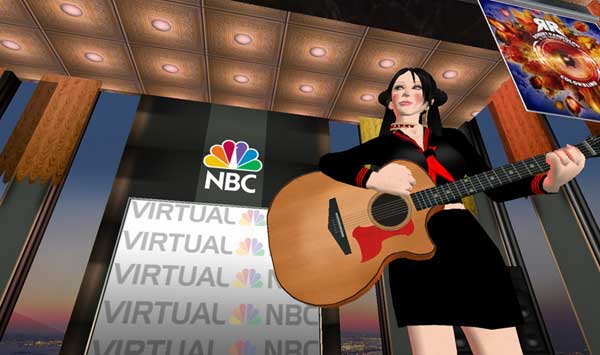
曹斐,錄像,28分鐘,2007。維他命空間提供
什麼是虛擬,什麼是真實,或許不再重要,它們已經邊界模糊,在虛擬世界的我們,不是我們本身,恰恰又是我們,我們總是質疑虛擬空間對現實的侵蝕,但是否我們依然能夠在虛擬社會找到一種融合的可能,那是一種超越真實的力量,連接著真實的那端依然是人類對樸素的愛,對自由的追求,與其讓「神愛世人」,不如讓我們互相拯救吧。
— 中國‧翠西
It’s perhaps no longer important to draw the line between the virtual and the real, as the border between the two has been blurred. In the virtual land, we are not what we originally are, and yet we remain unchanged. We always worry about the virtual space’s erosion of reality, but hopefully there’s new possibility of combination in our electronic second life, a new force which transcend this mortal coil. On the reality’s end of this combined ultra-space there are still love for simplicity and the pursuit of freedom. God loves people, but we are also each other’s salvation.
—China Tracy
Cao Fei,Video, 28 mins, 2007. Courtesy of Vitamin Creative Space
Director: China Tracy
Camera & Editor: China Tracy
Music: Prague: Bridge ( “Balcony”, “Elegy”, “Heidegger Cafe” )
SL Sound Recorder: Zafka Ziemia
Actor: Hug Yue
Actress: China Tracy
Assistant: Rivers Singh, Sean Frederix, Thomas Oh
Translator: Lawrence Dutton
﹉﹉﹉
ꕥ 作品介紹 2
人民城寨的生活 Live in RMB City
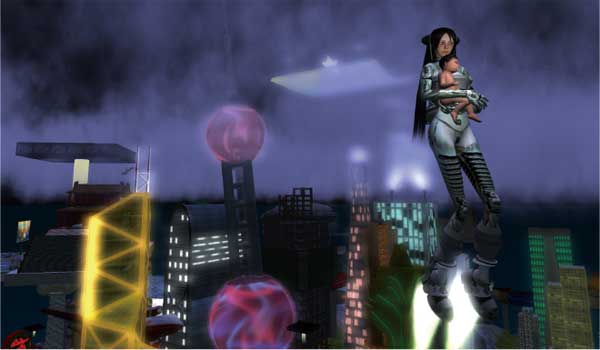
曹斐,錄像,25分鐘,2009
中國‧翠西在Second Life裡建設了一個主題公園:人民城寨,這裡是一個濃縮了幾乎所有中國當代城市特徵的新城,它是一系列高度自相矛盾的、相互整合的、充滿揶揄與質疑的、同時散佈極度娛樂和政治意識的新中國畫境。
《人民城寨的生活》記錄了第二人生的新生兒,中國‧翠西的孩子中國山,在第二人生第一次的呼吸,害怕與好奇。鏡頭跟隨著小baby中國山在人民城寨的漫遊與探險,為我們呈現了再生了的人民城寨:在生活清流的灌溉下,受不同的藝術家、作者、建築師、哲學家等合作者的啟發而一起創造的各種新生事物。這是一次神奇的,令人興奮而不可預知的旅行。
Cao Fei,Video, 25 min, 2009
China Tracy build a city dubbed RMB City within Second Life. This is the condensed incarnation of contemporary Chinese cities with most of their characteristics; a series of new Chinese fantasy realms that are highly self-contradictory, inter-permeative, laden with irony and suspicion, and extremely entertaining and pan-political.
A fantastic, exciting and unpredictable journey, the video ‘Live in RMB City’ follows the first breaths, fears and curiosities of newly born China Sun, the baby of China Tracy, in Second Life. The camera follows baby China Sun’s wanderings and explorations in a revived RMB City, inspired by brand new additions created by a team of artist, writer, architect, and philosopher collaborators, and infused with a fresh stream of life.
﹉﹉﹉
ꕥ 作品介紹 3
城市 City
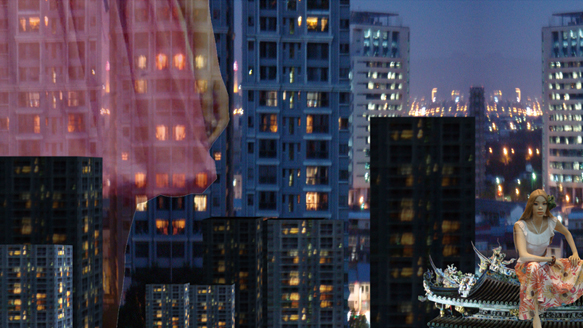
陳依純《城市》,錄像,3分08秒,2009
核心與邊陲的地域區塊,仍舊是存在著顯著的差異。而交錯來往在這之間,身體產生的斷裂感,讓人迷網自己的歸屬何在。而外在環境的落差侵襲著心智,逼迫自己 能瞬時轉換身體語言,去適應當下現況的種種突發現象。在這轉變間已無法妥善詮釋真實的「我」,無法只保有唯一一種人格型態。
I-Chun Chen, Video , 3mins 08secs, 2009
The initial idea of the piece derives from the intention to express the conceptual difference between the city’s core and margin. By passing in between these two parts of the city in one day, one could sometimes feel a sense of bewilderment, and questions where does one belong?
﹉﹉﹉
ꕥ 作品介紹 4
一封可憐的信件標題,當你開啟卻中毒了!
An Email with Pitiable Subject, You Are Attacked by Virus!
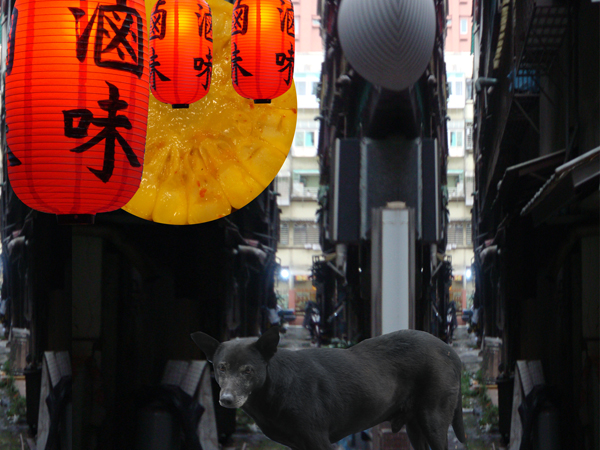
陳依純,錄像,3分,2008
住在工業區裡,黃昏來到,通往外界的連絡方式只剩下網路的世界。現實的工業環境是如此的混亂,為求安全只能將自己困在這裡。開啟電子信箱,以為收到朋友來信的問候,卻沒想到只是一個廣告或詐騙。而這過程雖短暫卻也能藉由得到慰藉,直到自行揭開真相。
I-Chun Chen, Video , 3mins, 2008
﹉﹉﹉
ꕥ 作品介紹 5
上海,我能請你跳支舞嗎? Shall We Dance, Shanghai?
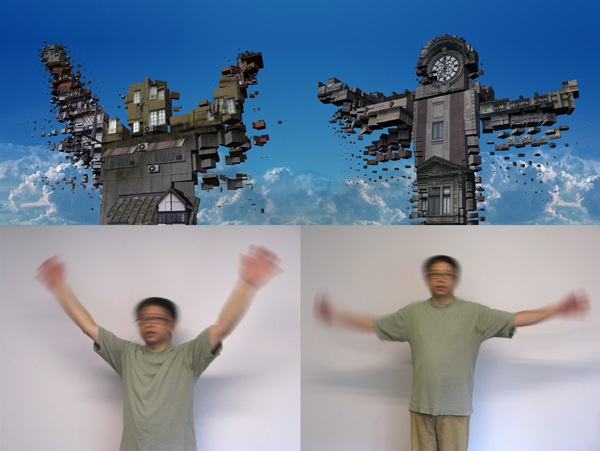
黃心健,互動裝置, 2008。故事巢提供
城市,常讓人覺得巨大,冷漠,尤其是現代化的高樓,人被掩蓋於冰冷的玻璃帷幕後,大型商業看板之下;建築的巨大量體,永恆不變的存在感,與其代表的經濟力量,人常覺得渺小,無力,短暫的存在,被城市所擺佈。小市民終其一生,在它的陰影下活動,由其所構築的迷宮中奔波,求得一家的生計。
然而,城市看似冰冷的外表,卻是由人們集體的意志所建造,每一個建築都是收容人們記憶的載體;移民沈澱為市民,市民建構了城市,也移動了城市。只是,越是現代化的建築,其外表代表個人的視覺元素越加稀少。
在這裡,我想做個瘋狂的夢:城市,是否可以隨著一個人的身影,在一首狂想曲中起舞?城市的建立與傾頹,就發生在一個小市民的扭腰擺臀之間。經由互動裝置,將人民廣場周圍,從古到今的地標性建築,隨著參訪者的身影翩翩起舞,沈重的水泥磚塊與鋼鐵招牌,輕盈地在手足迴旋之間搭建與散落,將旅者的身影,與城市建築重疊交織,重新建立起人與城市的直接對話。
Hsin-Chien Huang,Installation, 2008
﹉﹉﹉
ꕥ 作品介紹 6
歿日 Dying Sun

賴俊羽,錄像裝置,3分,2011
後資本時代裡,人類不斷的開發自掘,全球化、戰爭、剝削、壟斷、殖民、環保、人口膨脹、階級性、貧富差距等。所有的問題掩飾在各種商業行為的模式裡,人類習以為常失去了感知能力,身在其中卻無法覺醒,盲目的追求走向無止盡黑暗的深淵。末日論的預言以各種形式在這座城市裡重複發生。署光逐漸消逝,在黑暗來臨之前,母體已自行毀滅,自我的一切無法連續,「崩解」是對這座城市所發出的無聲吶喊 。
Chun-Yu Lai,Installation, 3min, 2011
In the age of post-capitalism, human beings consistently develop and therefore cause problems like globalization, exploitation, monopolization, colonization, environment contamination, population expansion, hierarchicalization, and wealth gap between the rich and poor. All the problems have been concealed among all kinds of commercial activities; hence, people who lose the ability of perception, are unable to awake from this nightmare, and only blindly walk toward a dark abyss. Apocalyptical prophecies have been repeatedly occurred in this city with various forms. Before darkness, light has died away. The matrix has been self-destructed because everything about self cannot be continued. “Disintegration” is the voiceless outcry that has been made toward this city.
﹉﹉﹉
ꕥ 作品介紹 7
拉距 Tension
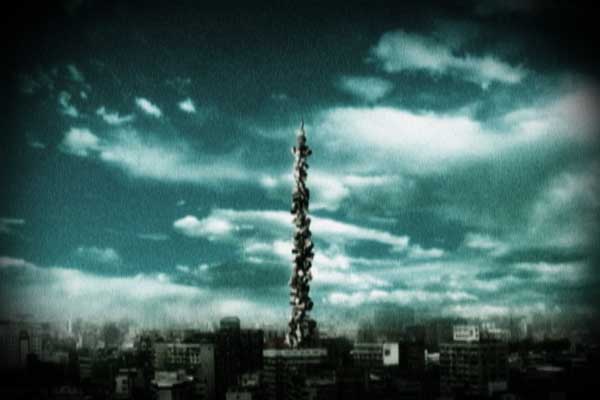
賴俊羽《拉距》,電腦動畫,2分32秒,2007
在全球化的高速發展下,都市及生活結構後殖民時代形成了在資本化下的拉距,新的消費形式置入,在區域上形成了階級化在聚落造成現象空間斷層。傳統的市場組織行為在空間與時間上的行動上被新的全球化消費行為入侵,建立出新型態的空間與時間的消費行為。新的集體式聚合的區域性消費模式行為改變新的個體(個人消費者)對於個體(個人的販賣)的單一性,群體的關係牽制個體的價值觀點與自主性,消費型態因而快速的形成新式與舊式的兩種生活文化與消費行為的對立與落差。
Chun-Yu Lai, Computer Animation, 2mins 32Secs, 2007
With the high-speed development of globalization, city and its life structure in the post-colonial era have raised a tension between capitalizations— the emergence of a new form of consumption which results in not only hierarchicalization but also spatial discrepancy in regional areas. The mode of traditional market is spatial-temporally invaded by new globalized consumption, and in consequence a new spatial-temporal pattern of consumption is created. The tendency of this new regional and collective consumption pattern has changed the unilateral dimension in which a new individual (individual consumer) toward an individual (individual selling), because the interrelationship within the group limits individual criteria and autonomy; hence, this new consumption pattern rapidly causes opposition and discrepancy between the new and old world respectively.
﹉﹉﹉
ꕥ 作品介紹 8
卉花博覽會 Disappeared Flora Exposition
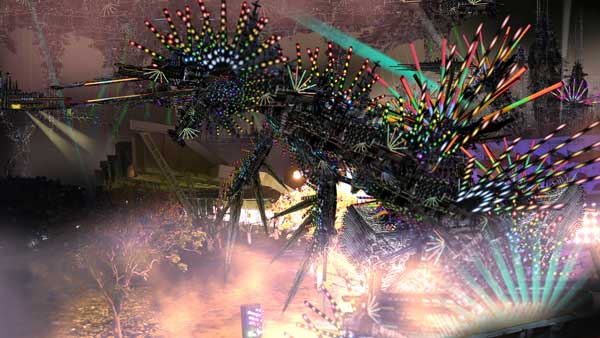
李文政,電腦動畫,3分,2011 動畫協力:蔡柏瑞
在宣傳的轟炸後、一起辛苦的排隊、努力報導弊案、立場上反對的政治、卉花的廣告到處開、短命公園換建案、國際活動變成本土觀光景點、房價房租的高漲、是否提昇花卉的產業沒人報、正面的內涵沒人理、花博變卉花。喧嘩過後還剩下什麼?美麗的力量還可用多久?期待結束後,讓花不只是卉花。
Computer Animation, 3min, 2011 Animation:Bo-ruei Cai
After numerous propaganda, laborious queues, scandal reports, antagonistic politics, everywhere flora advertisements, short-lived park reconstruction cases, the rise of housing prices, and international events becoming a local tourist site, is it any possibility that anybody report on how to promote flora industry, and that anybody cares about the positive aspect of the content? Does Flora Exposition become painting flowers? What is left after all the clamoring? How long will beautiful power last? When all ends, let flowers no more be painting flowers.
﹉﹉﹉
ꕥ 作品介紹 9
盛開系列《生存空間》Blooming Series
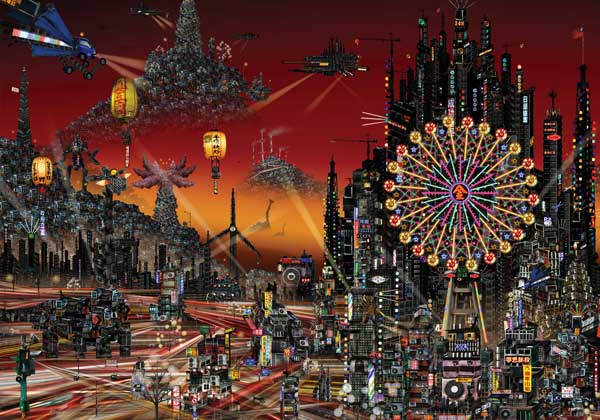
李文政,,數位影像輸出,240cmX120cm,2010
作品為表象外所存在的生命力與想像空間的再現,並實驗台灣現有元素的重組與新語言,持續的田野調查與創作中,瞭解表面之外有更多的現象與狀態,令人困惑動,為尋常的台灣都市環境,與庶民生活的狀況,並加上藝術家本身的想像力,重新加以詮釋,讓觀者也一同對環境有新的解讀與瞭解。
Digital Print, 240cm x 120cm, 2010
By experimenting and integrating Taiwan elements and Taiwan new language, these works represent the vitality existed beyond the material surface as well as imaginary space, by means of constant field-trip investigation and creation, in order to explore puzzling and affecting experiences of Taiwan urban environment and of the life of common people. In addition, with artist’s imagination, these works not only reinterpret but also show innovative aspects of our surroundings for viewers.
﹉﹉﹉
ꕥ 作品介紹 10
盛開系列《飛蛾》Blooming Series
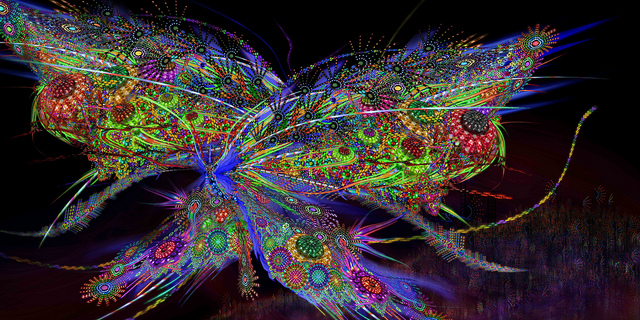
李文政,,數位影像輸出,240cmX120cm,2010
作品為表象外所存在的生命力與想像空間的再現,並實驗台灣現有元素的重組與新語言,持續的田野調查與創作中,瞭解表面之外有更多的現象與狀態,令人困惑動,為尋常的台灣都市環境,與庶民生活的狀況,並加上藝術家本身的想像力,重新加以詮釋,讓觀者也一同對環境有新的解讀與瞭解。
Digital Print, 240cm x 120cm, 2010
By experimenting and integrating Taiwan elements and Taiwan new language, these works represent the vitality existed beyond the material surface as well as imaginary space, by means of constant field-trip investigation and creation, in order to explore puzzling and affecting experiences of Taiwan urban environment and of the life of common people. In addition, with artist’s imagination, these works not only reinterpret but also show innovative aspects of our surroundings for viewers.
﹉﹉﹉
ꕥ 作品介紹 11
看見不見的海 Seeing Invisible Ocean

藝術家:李文政 動畫協力:蔡柏瑞 音樂協力:溫子捷、歐比王(神棍樂團主唱)
輕微的浪紋,在海的薄膜上迸裂成氣沫,
薄霧轉濃,使遠方的物影飄忽迷離,
在幽暗深邃的黑霧裡,遙測巨大現實氣息的聲距,
將於分秒間襲來。
一旦進入不斷溢出的液態土地上,你還能潛行嗎?
人群流動的線索、交疊、關節延伸,眾多來自小範圍的秩序化、慾望的形體模組,重組接合成可供日誌轉述的豐饒象限,因此這不是座龜裂脆弱的島嶼,而是一片不斷溢出城市的海。它本應該寂靜無聲息,寥廓無形體,獨立存在而不消失,循環運行而不停止,那股無所不至的驅力,將在波腹下無垠鑲嵌滋生、刺穿表面張力侵襲攀爬而上,試圖恢復感知疲乏的平衡,我不知道它的名字,或許它就是所有人與物件的投射。
在這液態的流動裡,人類生活尺度的複雜運作,標出海平面的上與下隱沒、現出的陳列刻度、展開扇軸掠取皺褶裡的陰陽光景,以一種沒有終點的航道里程行駛。
驀然間,凸起的繁華紛亂,再度消失於平滑切割的起點,沒有痕跡,空茫一
片,縱使還存於那裡,或許下回你將認為它是以花的盛開方式,重新綻放。
Wen-Cheng Lee Animarion:Bo-ruei Cai Music:Tzu-Chieh Wen Obiwan(Zenkwun)
The gentle sea waves disintegrate into bubbles and foams on the blue skin of the sea. As the light haze thickens, everything faraway becomes vague and vaporous.
I anticipate, in the deep, dark fog, that the distant waves will come surging over in just seconds.
Can you continue surfing, once you have dived into the constantly overflowing liquid earth?
Signs of the movement of people overlap and extend. The ordering of things and events in small scale are coupled with desire to form a new, narratable dimension. We can finally see that this is not a fragile, crackled island, but a sea of liquid soil that constantly overflows the city. Silent, boundless and shapeless. Self-contained yet existent. Self-recycling and never-ending. It has a kind of omnipresent aggressive drive grows from underneath the wave and subsequently penetrates through its surface to climb upwards in order to rejuvenate and refresh. I have no idea what its name is; perhaps it is a projection of all kinds of people and things.
As the liquid flows, the complex activities of everyday living mark the range of visibility below the sea, and sail away into an endless journey.
Suddenly, the noisy yet splendid world disappear at the cutting start point without leaving any trace, even though it remains where it was. Some day, it may open up again like flowers blossom.
﹉﹉﹉
ꕥ 作品介紹 12
微訊 Micro-signal
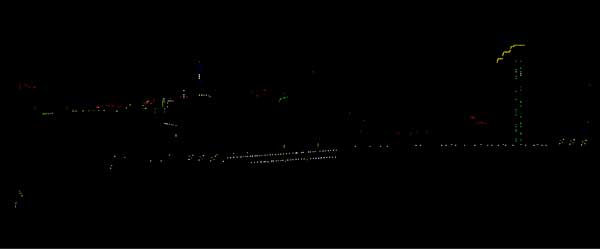
葉姿秀,空間裝置, 2011
透過時下科技的媒體介面,使人的感知系統延伸、擴大,已內化為生活當下不能忽略的體驗,身體感知也在使用電子媒體後被系統化,或許,反過來我們正以「虛擬」化身體運作系統去經驗「現實」的外在。隨身的口袋裡、房間內、城市街道上…隨處都充滿著供給各種訊號光源的機體,生活裡不自覺以這些訊號源所餵養,人的存在也轉化成訊號移動的連接點,藉由這件裝置呈現一個關於城市積體的概念。
Tzu-Hsiu Yeh, Installation, 2011
In this creation, the presentation is made through LED installation of flicker signal. The flickering of the light source in the system represents a stand-by mode; I tied the indicator lights of power switches to an urban scene, unveiling a hidden gigantic network through the flickering of the lights. The conception of this artwork is about the Integrated Circuit City.
ꕥ 相關活動
開幕茶會 Opening
2011/03/12 (Sat.) 15:00
藝術家論壇 Artist Forum
2011/03/19 (Sat.) 15:00
主持人: 謝慧青
與會藝術家: 李文政、陳依純、賴俊羽、葉姿秀
2011/03/26 (Sat.) 15:00
講座: 故事巢數位藝術創作與媒體科技運用
講者:黃心健
專家導覽 Exper Guide
2011/03/20 (Sun.) 15:00 朱惠芬(視盟榮譽理事長)
2011/03/27 (Sun.) 15:00 駱麗真(世新大學公廣系助理教授)
2011/04/03 (Sun.) 15:00 謝慧青(策展人)
 EXHIBITION
EXHIBITION
